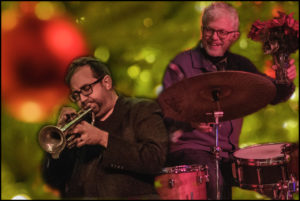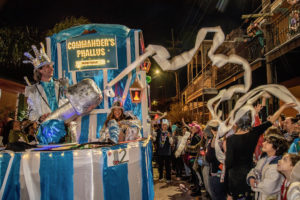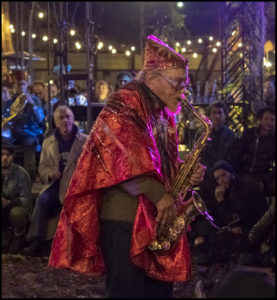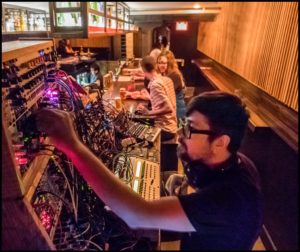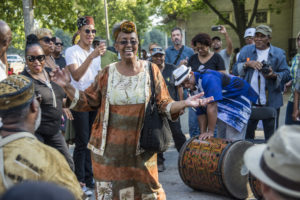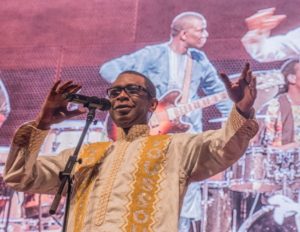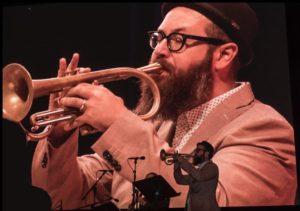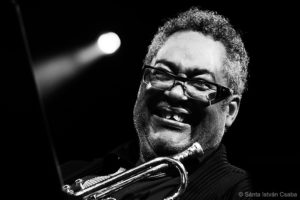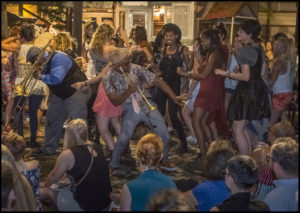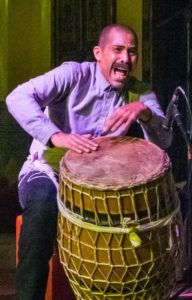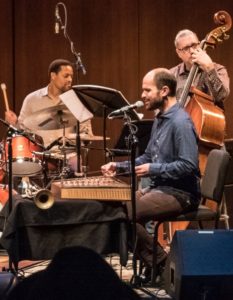Despite my avowed abhorrence of Christmas music, I enjoyed maestro Kurt Elling leading his hometown quintet in a holiday-themed performance at Chicago’s City Winery last Sunday. My entire evening — accompanied by best friends, and including the surprise discovery after the Winery show of a heartening young trumpeter at the Hungry Brain — was a […]
City of Chicago, music promoter
Lollapalooza 2021 had some 385,000 attendees (without significant Covid-19 outbreak, fortunately) but featured little of host Chicago’s indigenous talent or styles. And that’s just wrong, declared Department of Cultural Affairs and Special Events commissioner Mark Kelly, launching the month-long Chicago in Tune “festival” at a reception August 19. Here’s the still-evolving event calendar of hundreds […]
Mardi Gras’ lewd Krewe, Marc Pokempner’s photos
Satirical, scatalogical New Orleans parade floats by Krewe du Vieux Carré, via photojournalist Marc PoKempner
Extraordinary Popular Delusions, Chicago free improv all-stars
Keyboardist and synthesizer specialist Jim Baker has led the collective quartet Extraordinary Popular Delusions playing every Monday night in obscure Chicago venues for the past 13 years. My article on EPD, which features saxophonists Mars Williams and Edward Wilkerson Jr. (they switch off), multi-instrumentalist (bass, guitar, trumpet) Brian Sandstrom and percussionist/drummer Steve Hunt — all […]
Luminous PoKempner pix of Sun Ra’s celestial music
Marshall Allen, ageless 94, leads the Sun Ra Arkestra If you liked Black Panther, listen to the music that introduced and embodies Afro-Futurism. Photojournalist Marc PoKempner captured a bit of the celestial magic of the Sun Ra Arkestra (est. circa 1954) during its November touchdown in New Orleans’s Music Box Village. This picturesque venue is […]
Synth and-sushi bar, Chicago (future jazz, present tense)
K-rAd freely improvised and spontaneously composed an original, pulsing, burbling, chiming, floating and ripping, multi-layered, deep and flowing funky-bassed, percussion-lively suite over about three hours last night (7/25/18), using his elaborate, sound-unbound Euro-rack synthesizer setup to stir, smooth and spice social interactions in a seemingly unlikely Chicago venue for such a thing. Down an alley, through a back […]
Jazz community upends Englewood’s bad rep
The 18th annual free Englewood Jazz Festival in south side Hamilton Park last Saturday (9/16) affirmed the best of Chicago’s grassroots culture, promoting an opposite image of this challenged neighborhood as a dangerous place — unless one fears powerful, creative music that speaks as directly as dance rhythms to its family of listeners. Produced on behalf of the Live […]
Youssou N’Dour on stage & screen, PoKempner photos
Photo-journalist Marc PoKempner‘s images from the Chicago Jazz Fest, as featured in my previous post, and these from Senegalese superstar Youssou N’Dour’s rousing who two weeks earlier, exhibit how he’s dealing straightforwardly and creatively with the screen backing musicians at the Pritzker Pavilion of Millennium Park. Giving us eyefuls to enjoy. Here’s what we can […]
Jazz on Millennium Park’s big screen – PoKempner photos
A 40-by-22½-foot LED screen is a dominating feature of the stage in the Pritzker Pavilion of Chicago’s Millennium Park, difficult to ignore though many try. Photographer Marc PoKempner does the opposite in his shots from the 39th annual Chicago Jazz Festival: he uses what he (and everybody else) sees to create striking images, in the […]
Great new jazz photography: Sánta’s faces of Northsea Jazz Fest
The faces of jazz musicians Sánta István Csaba hears, sees and snaps are indelibly expressive — like the memorable phrases, inspired improvisations and magical connections these players play, so meaningful to listeners in the moment, remembered or recorded. JazzTimes magazine has published some of Sánta’s images from the Northsea Jazz Festival in early July — here are […]
Great new jazz photography: Marc PoKempner portfolio from New Orleans
Photos of musicians making music — visualizations stirred in the photographers by watching sounds manifest — are exciting, and as different in style as the photographers and musicians themselves. Marc PoKempner ‘s portfolio from New Orleans of the Preservation Hall Jazz Band with Cuban drummers at the Music Box Village, a non-profit community arts garden, is the first of […]
Jazz warms Chi spots: Hot House @ Alhambra Palace, AACM @ Promontory
There are good arguments for building venues just for jazz. But speaking of arts communities in general: Most are moveable feasts, fluid, transient, at best inviting to newcomers to the table. It’s demonstrable that when jazz players and listeners alight at all-purpose spaces such as Chicago’s Alhambra Palace, where Hot House produced the trio of saxophonist David Murray, bassist […]
African roots, Middle Eastern extensions in Hyde Park Jazz Fest
Pianist Randy Weston, a magisterial musician at age 90 inspired by jazz traditions and its African basics, and trumpeter Amir ElSaffar, who has devoted himself to incorporating the Middle East’s modal, microtonal maqam legacy into compositions for jazz improvisation by members of his Two Rivers Ensemble, were highlights of last weekend’s 10th annual Hyde Park Jazz Festival. Both […]

